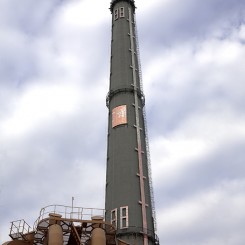It is September 28, three days before the opening of the Shanghai Biennale, and the museum is definitely not ready for business. The Power Station of Art — Shanghai’s new contemporary art museum — is a hotbox of solvent fumes and dust. Sparks fly from welders soldering on the arms of Huang Yongping’s 20-meter-tall Boddhisattva sculpture (“Thousand-Armed Kuanyin,” 1997-2012). Meanwhile, workers carrying 5-meter-long bamboo poles dodge giant copper fragments of the statue of liberty (Danh Vo’s “We the People”).
Artist Chico MacMurtrie was donning an industrial gas mask in the early days of the installation and trying his best to prevent his robotic Transformers-like car sculpture (“Totemobile 2006) from being coated in dust from the wheel of a nearby skillsaw. Earlier, he told us, workers had damaged his work when, while cleaning the vertical concrete columns in the museum, a huge chunk of concrete fell and dented the roof of his car sculpture.
A state of such extreme chaos is nothing new to the Shanghai Biennale, but the scope of this year’s ambitions combined with the requirement that the biennale be held in a new and at the time unfinished space took the absurdity to a whole new level.
“The Shanghai Biennale is always finished at the very last minute,” says Li Xu, the Deputy Director of Planning at the Power Station of Art, “We had lots of problems because the building was not clean. It was so dusty some artists were unwilling to open their crates. Every year there are lots of difficulties — in fact, all biennales are in a state of chaos in the days leading up to the opening. It’s not like a solo show where everything is planned well in advance.”
The normal eleventh-hour state of affairs was compounded by the move to a new location, the PSA, which was formerly a “dirty coal plant” closed in 2007. It later became the Urban Best Practices pavilion during the 2010 Shanghai World Expo and was recently renovated into a bright, somewhat Pompidou-like space, with a high-ceilinged atrium, escalators and some original architectural features such as the smokestack and a crane mounted overhead.
The space was originally supposed to be finished by September 1, but according to the chief curator Qiu Zhjijie, it was only handed over to the team on September 21 to begin installing, with renovations continuing throughout the installation process. Huang’s “Thousand-Armed Kuanyin” (1997-2012), for instance, was installed over the space of several days. When we arrived on Sep 27, only a quarter of the arms were attached, but as quickly as the next afternoon about 80% of them were finished — as though a PLA-sized army of welders had been brought in overnight.
There was a scrum at the gate where artists and curators who were participating or involved in the project could not gain entry to the opening; meanwhile, hoards of students and senior citizens who had likely been given free tickets by their government work units streamed through the gate. Opening times for various events were changed and blurry site maps were few and far between. Post-opening visits are equally trying as guests are required first to book tickets online (through a Chinese-only website; link here), then pick them up at separate locations around the city before heading to the museum itself. It’s a plan so irrational that it could be construed as a deliberate attempt to thwart enthusiasm for contemporary art.



